欧洲皮肤病学论坛-局部光动力疗法指南
- 格式:pdf
- 大小:327.39 KB
- 文档页数:16
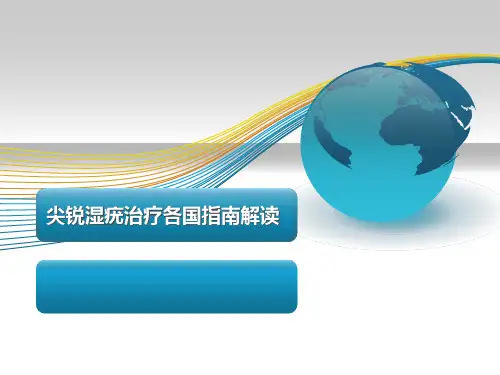

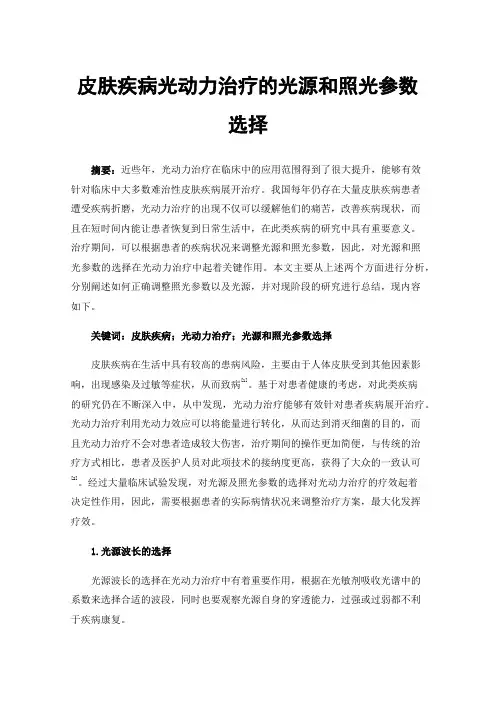
皮肤疾病光动力治疗的光源和照光参数选择摘要:近些年,光动力治疗在临床中的应用范围得到了很大提升,能够有效针对临床中大多数难治性皮肤疾病展开治疗。
我国每年仍存在大量皮肤疾病患者遭受疾病折磨,光动力治疗的出现不仅可以缓解他们的痛苦,改善疾病现状,而且在短时间内能让患者恢复到日常生活中,在此类疾病的研究中具有重要意义。
治疗期间,可以根据患者的疾病状况来调整光源和照光参数,因此,对光源和照光参数的选择在光动力治疗中起着关键作用。
本文主要从上述两个方面进行分析,分别阐述如何正确调整照光参数以及光源,并对现阶段的研究进行总结,现内容如下。
关键词:皮肤疾病;光动力治疗;光源和照光参数选择皮肤疾病在生活中具有较高的患病风险,主要由于人体皮肤受到其他因素影响,出现感染及过敏等症状,从而致病[1]。
基于对患者健康的考虑,对此类疾病的研究仍在不断深入中,从中发现,光动力治疗能够有效针对患者疾病展开治疗。
光动力治疗利用光动力效应可以将能量进行转化,从而达到消灭细菌的目的,而且光动力治疗不会对患者造成较大伤害,治疗期间的操作更加简便,与传统的治疗方式相比,患者及医护人员对此项技术的接纳度更高,获得了大众的一致认可[2]。
经过大量临床试验发现,对光源及照光参数的选择对光动力治疗的疗效起着决定性作用,因此,需要根据患者的实际病情状况来调整治疗方案,最大化发挥疗效。
1.光源波长的选择光源波长的选择在光动力治疗中有着重要作用,根据在光敏剂吸收光谱中的系数来选择合适的波段,同时也要观察光源自身的穿透能力,过强或过弱都不利于疾病康复。
临床中常用的氨基酮戊酸与甲基-氨基酮戊酸在光敏剂中都属于前体物质,甲基-氨基酮戊酸与氨基酮戊酸相比,具有较高的脂溶性,二者可以转化成为原卟啉IX,综上得出,二者与原卟啉IX的吸收光谱一致。
原卟啉IX有五个吸收峰,依次为410、510、545、580以及630mm,所有吸收峰中临床应用较广的是410nm蓝光以及630nm红光,前者的优势在于具有较大的原卟啉IX吸收系数,后者的优势在于具备更强的穿透能力。

光动力疗法一概述光动力疗法(PDT)是一种治疗尖锐湿疣的新方法,目前已在临床广泛使用。
光动力疗法是一种联合应用光敏剂及相应光源,通过光动力学反应选择性破坏肿瘤组织的全新治疗技术。
二原理将光敏剂输入人体,在一定时间后,以特定波长的光照射病变部位,通过一系列光化学和光生物学反应,在分子氧的参与下,产生单态氧和/或自由基,氧化破坏组织和细胞中的各种生物大分子,使异常增生活跃的细胞发生不可逆的损伤,最终使细胞死亡,达到治疗目的。
三适应证1.癌前期皮肤病和皮肤恶性肿瘤如:日光性角化病,基底细胞癌,鳞癌;2.治疗非恶性肿瘤性皮肤病如:尖锐湿疣,血管畸形,寻常痤疮。
四步骤1.由医护人员随用随配新鲜药液,以备治疗时使用。
2.新鲜药液湿敷患处3小时,并根据具体情况进行相应的局部封包。
3.红光照射病灶局部,照射时间通常为20分钟。
五不良反应最常见不良反应是照光时局部出现针刺样疼痛,大部分患者可以忍受,或稍后会自行缓解,一般无须做特殊处理。
嘱咐患者不必过度紧张,对疼痛明显者,可局部外用“复方利多卡因乳膏”或通知医生做其他进一步其他特殊处理。
六费用1.药物的费用盐酸氨酮戊酸(艾拉,ALA)每支药物800多元。
一般面积不是很大的尖锐湿疣患者,每次治疗使用1支。
面积大则增加用量。
2.治疗费用每次约300元/光斑,一般局部照光时间为20分钟。
3.时间通常每周治疗1次,约半天时间;3次为一个疗程。
七注意事项1.特殊部位的尖锐湿疣(如疣体发生在尿道口、尿道内、外阴部腺体开口周围的)可以直接选择光动力治疗,疗效好,复发少。
2.局部二氧化碳激光或冷冻治疗后,反复复发的患者,建议局部光动力治疗2~3次。
3.常规传统治疗后,可以选择光动力治疗2~3次,进行巩固治疗,防止复发。
4.对较大的疣体,建议先用二氧化碳激光或冷冻的办法去除大的疣体后,再选择光动力治疗,这样既可以减少治疗费用,又能缩短治疗时间。
5.任何一种治疗目前都不能绝对防止尖锐湿疣的复发,一般光动力治疗3次后,疣体复发率小于10%。
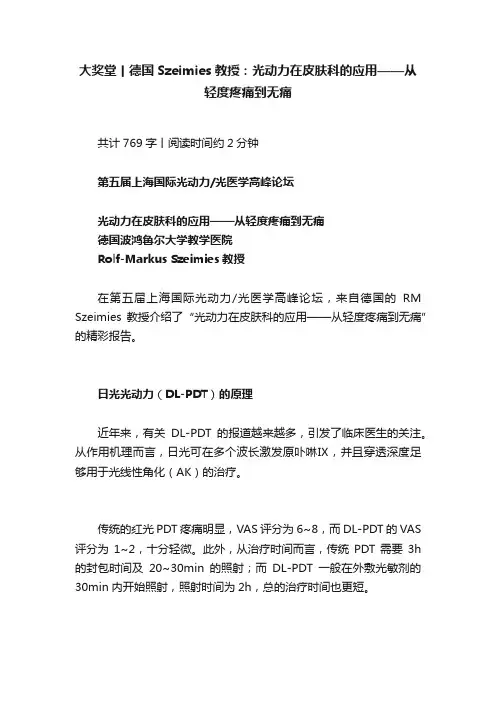
大奖堂丨德国Szeimies教授:光动力在皮肤科的应用——从轻度疼痛到无痛共计769字丨阅读时间约2分钟第五届上海国际光动力/光医学高峰论坛光动力在皮肤科的应用——从轻度疼痛到无痛德国波鸿鲁尔大学教学医院Rolf-Markus Szeimies教授在第五届上海国际光动力/光医学高峰论坛,来自德国的RM Szeimies教授介绍了“光动力在皮肤科的应用——从轻度疼痛到无痛”的精彩报告。
日光光动力(DL-PDT)的原理近年来,有关DL-PDT的报道越来越多,引发了临床医生的关注。
从作用机理而言,日光可在多个波长激发原卟啉Ⅸ,并且穿透深度足够用于光线性角化(AK)的治疗。
传统的红光PDT疼痛明显,VAS评分为6~8,而DL-PDT的VAS 评分为1~2,十分轻微。
此外,从治疗时间而言,传统PDT需要3h 的封包时间及20~30min的照射;而DL-PDT一般在外敷光敏剂的30min内开始照射,照射时间为2h,总的治疗时间也更短。
DL-PDT的临床研究多篇的研究报道,以MAL为光敏剂的DL-PDT皮损清除率较高,为68%~79.5%,且治疗几乎无痛。
随机、双盲COMET1&2研究对比了DL-PDT和传统红光PDT(c-PDT)治疗轻-中度AK的疗效和安全性。
DL-PDT的治疗流程为:治疗前使用化学性防晒剂,后进行皮肤预处理,并应用MAL,在30min内开始进行日光照射,照射时间2h。
c-PDT的治疗流程为:皮肤预处理后应用MAL,封包3h,后洗去MAL,照光3h。
COMET1纳入患者均为轻度AK,COMET2纳入患者为轻~中度AK。
研究结果显示,DL-PDT的疗效非劣于c-PDT。
在晴天或多云天气进行PDT照射均能取得良好的疗效。
在疼痛方面,82%~91%的患者在治疗过程中未报告有任何疼痛。
除了COMET1&2研究以外,近年来也有其他研究证实了DL-PDT 的疗效。
DL-PDT在指南中的地位及优缺点2015,欧洲已经发表了DL-PDT治疗AK的共识。
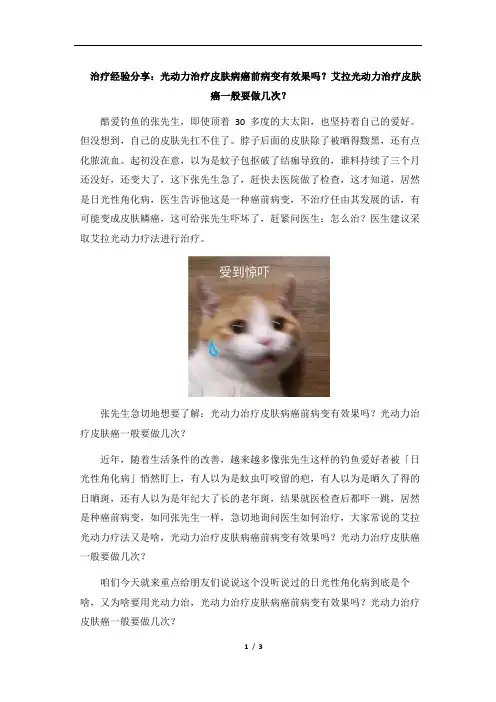
治疗经验分享:光动力治疗皮肤病癌前病变有效果吗?艾拉光动力治疗皮肤癌一般要做几次?酷爱钓鱼的张先生,即使顶着30 多度的大太阳,也坚持着自己的爱好。
但没想到,自己的皮肤先扛不住了。
脖子后面的皮肤除了被晒得黢黑,还有点化脓流血。
起初没在意,以为是蚊子包抠破了结痂导致的,谁料持续了三个月还没好,还变大了,这下张先生急了,赶快去医院做了检查,这才知道,居然是日光性角化病,医生告诉他这是一种癌前病变,不治疗任由其发展的话,有可能变成皮肤鳞癌,这可给张先生吓坏了,赶紧问医生:怎么治?医生建议采取艾拉光动力疗法进行治疗。
张先生急切地想要了解:光动力治疗皮肤病癌前病变有效果吗?光动力治疗皮肤癌一般要做几次?近年,随着生活条件的改善,越来越多像张先生这样的钓鱼爱好者被「日光性角化病」悄然盯上,有人以为是蚊虫叮咬留的疤,有人以为是晒久了得的日晒斑,还有人以为是年纪大了长的老年斑,结果就医检查后都吓一跳,居然是种癌前病变,如同张先生一样,急切地询问医生如何治疗,大家常说的艾拉光动力疗法又是啥,光动力治疗皮肤病癌前病变有效果吗?光动力治疗皮肤癌一般要做几次?咱们今天就来重点给朋友们说说这个没听说过的日光性角化病到底是个啥,又为啥要用光动力治,光动力治疗皮肤病癌前病变有效果吗?光动力治疗皮肤癌一般要做几次?日光性角化病是啥?日光性角化病是一种特殊的皮肤癌前病变。
主要与长期接受紫外线照射、电磁辐射以及一些化学有毒物品有关,导致细胞基因突变,出现癌前变化,任由其继续发展的话,有可能转变为皮肤癌。
但庆幸的是,日光性角化病这种皮肤细胞癌前病变并非癌变,临床治愈率还是蛮高的,正确治疗后,复发率也很低,很多人经过积极治疗后就摆脱了这个暗暗作妖的小恶魔。
为啥用艾拉光动力治?日光性角化病的治疗方案其实还蛮多的,既往医生常用的治疗方法包括冷冻、激光、手术等,这些方法均能起到一定作用,但对于特定部位或特定个体难以达到理想效果,同时患者还要面临皮炎、瘢痕、色素沉着等不良后果,尤其是长在头、面部等暴露位置的日光性角化病患者,后期还可能需要持续的医美修复已消除这些瘢痕,长期算下来的话,费用不菲。
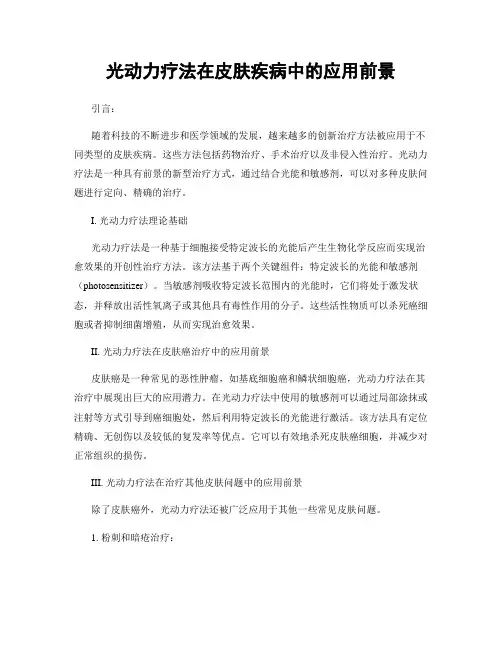
光动力疗法在皮肤疾病中的应用前景引言:随着科技的不断进步和医学领域的发展,越来越多的创新治疗方法被应用于不同类型的皮肤疾病。
这些方法包括药物治疗、手术治疗以及非侵入性治疗。
光动力疗法是一种具有前景的新型治疗方式,通过结合光能和敏感剂,可以对多种皮肤问题进行定向、精确的治疗。
I. 光动力疗法理论基础光动力疗法是一种基于细胞接受特定波长的光能后产生生物化学反应而实现治愈效果的开创性治疗方法。
该方法基于两个关键组件:特定波长的光能和敏感剂(photosensitizer)。
当敏感剂吸收特定波长范围内的光能时,它们将处于激发状态,并释放出活性氧离子或其他具有毒性作用的分子。
这些活性物质可以杀死癌细胞或者抑制细菌增殖,从而实现治愈效果。
II. 光动力疗法在皮肤癌治疗中的应用前景皮肤癌是一种常见的恶性肿瘤,如基底细胞癌和鳞状细胞癌,光动力疗法在其治疗中展现出巨大的应用潜力。
在光动力疗法中使用的敏感剂可以通过局部涂抹或注射等方式引导到癌细胞处,然后利用特定波长的光能进行激活。
该方法具有定位精确、无创伤以及较低的复发率等优点。
它可以有效地杀死皮肤癌细胞,并减少对正常组织的损伤。
III. 光动力疗法在治疗其他皮肤问题中的应用前景除了皮肤癌外,光动力疗法还被广泛应用于其他一些常见皮肤问题。
1. 粉刺和暗疮治疗:光动力疗法已经被证实可以显著改善粉刺和暗疮问题。
通过选择合适的波长和敏感剂,在发生粉刺和暗疮的区域使用光能进行治疗,可以清除堵塞的毛孔和杀死有害的细菌。
这种疗法具有高效、无创性和可重复使用的优点。
2. 血管扩张治疗:光动力疗法可用于治疗血管扩张的皮肤问题。
通过选择合适的波长,能够使血管收缩、闭塞,从而减少红斑和肿胀等现象。
这项治疗不仅能够改善外观,还能改善生活质量。
3. 皮肤色素沉积治疗:光动力疗法还可以用于治疗色素沉积问题,如黄褐斑或雀斑等。
特定波长的光能可以激活敏感剂,并刺激黑色素细胞产生氧化酶。
氧化酶可以降解多余的色素颗粒,并减轻斑点问题。
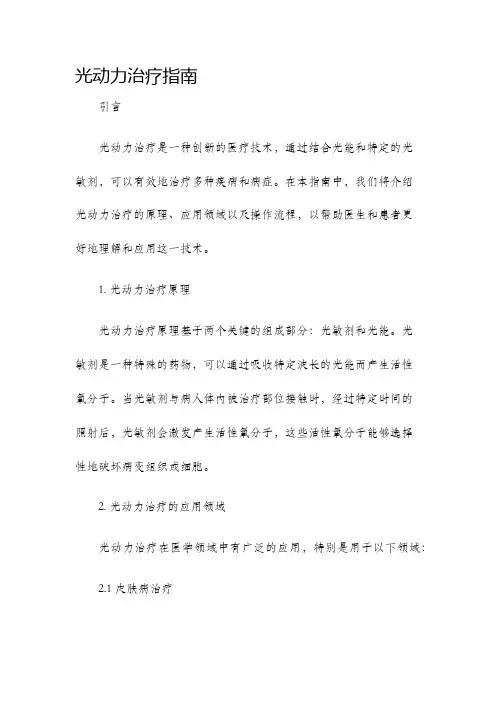
光动力治疗指南引言光动力治疗是一种创新的医疗技术,通过结合光能和特定的光敏剂,可以有效地治疗多种疾病和病症。
在本指南中,我们将介绍光动力治疗的原理、应用领域以及操作流程,以帮助医生和患者更好地理解和应用这一技术。
1. 光动力治疗原理光动力治疗原理基于两个关键的组成部分:光敏剂和光能。
光敏剂是一种特殊的药物,可以通过吸收特定波长的光能而产生活性氧分子。
当光敏剂与病人体内被治疗部位接触时,经过特定时间的照射后,光敏剂会激发产生活性氧分子,这些活性氧分子能够选择性地破坏病变组织或细胞。
2. 光动力治疗的应用领域光动力治疗在医学领域中有广泛的应用,特别是用于以下领域:2.1 皮肤病治疗光动力治疗被广泛应用于各种皮肤病的治疗,如痤疮、玫瑰痤疮、太田痣等。
这些疾病都是由细菌或细胞异常生长引起的,在光动力治疗中,光敏剂会被应用于皮肤表面,通过光能激活活性氧分子,达到杀灭细菌或破坏异常细胞的目的。
2.2 癌症治疗光动力治疗在癌症治疗中也显示出潜力。
光敏剂可以被应用于病变组织表面或局部,通过光动力激活活性氧分子,用于破坏癌细胞并刺激免疫系统的反应。
在某些情况下,光动力治疗可以作为辅助治疗手段,提高传统治疗方法的疗效。
2.3 眼科治疗光动力治疗在眼科领域中也得到了广泛应用。
例如,对于一些眼底疾病如黄斑部病变和青光眼等,光动力治疗可以通过光敏剂注射和激光照射的方式,达到对病变组织或细胞的治疗和修复。
3. 光动力治疗操作流程光动力治疗操作流程相对简单,具体步骤如下:3.1 光敏剂注射首先,根据患者的病情和需要,选择适当的光敏剂,并将其通过注射的方式输入到患者体内。
光敏剂的选择应根据患者的病情、病变部位和治疗目标来确定,医生应综合考虑患者的具体情况进行选择。
3.2 光敏剂激活光敏剂注射后,需等待一定的时间,使光敏剂充分分布到需要治疗的部位,然后用特定波长的激光对治疗部位进行照射。
激光的波长应与光敏剂吸收的波长相匹配,以激发活性氧分子的产生。
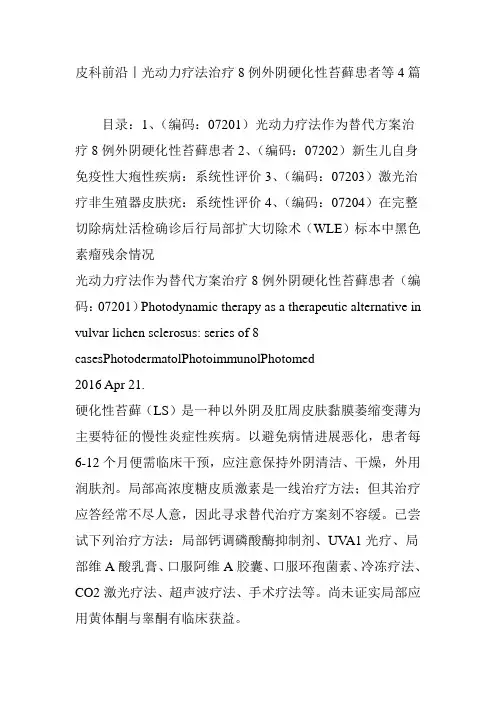
皮科前沿丨光动力疗法治疗8例外阴硬化性苔藓患者等4篇目录:1、(编码:07201)光动力疗法作为替代方案治疗8例外阴硬化性苔藓患者2、(编码:07202)新生儿自身免疫性大疱性疾病:系统性评价3、(编码:07203)激光治疗非生殖器皮肤疣:系统性评价4、(编码:07204)在完整切除病灶活检确诊后行局部扩大切除术(WLE)标本中黑色素瘤残余情况光动力疗法作为替代方案治疗8例外阴硬化性苔藓患者(编码:07201)Photodynamic therapy as a therapeutic alternative in vulvar lichen sclerosus: series of 8 casesPhotodermatolPhotoimmunolPhotomed2016 Apr 21.硬化性苔藓(LS)是一种以外阴及肛周皮肤黏膜萎缩变薄为主要特征的慢性炎症性疾病。
以避免病情进展恶化,患者每6-12个月便需临床干预,应注意保持外阴清洁、干燥,外用润肤剂。
局部高浓度糖皮质激素是一线治疗方法;但其治疗应答经常不尽人意,因此寻求替代治疗方案刻不容缓。
已尝试下列治疗方法:局部钙调磷酸酶抑制剂、UV A1光疗、局部维A酸乳膏、口服阿维A胶囊、口服环孢菌素、冷冻疗法、CO2激光疗法、超声波疗法、手术疗法等。
尚未证实局部应用黄体酮与睾酮有临床获益。
点击文章最下方【阅读原文】可下载全文新生儿自身免疫性大疱性疾病:系统性评价(编码:07202)Neonatal Autoimmune Blistering Disease: A Systematic ReviewPediatr Dermatol2016 Apr 18.本文旨在更好地了解新生儿自身免疫性大疱性疾病(AIBDs)的发病机制、临床特点、预后及治疗。
检索Medline、Embase、PubMed、Latin American & Caribbean Health Sciences Literature等数据库,追溯纳入文献的参考文献,补充获取相关文献。
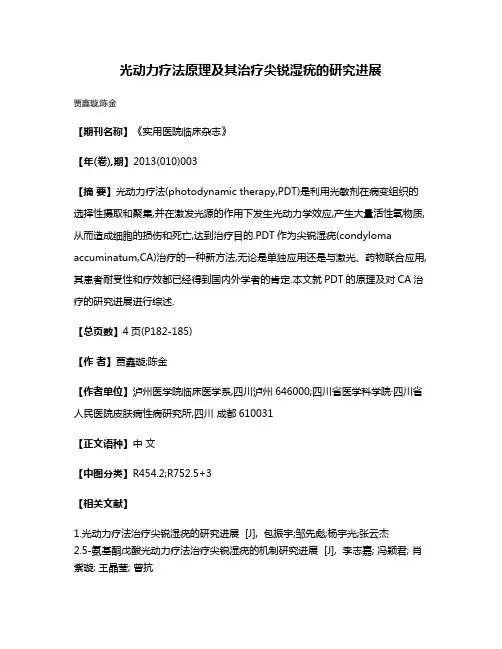
光动力疗法原理及其治疗尖锐湿疣的研究进展
贾鑫璇;陈金
【期刊名称】《实用医院临床杂志》
【年(卷),期】2013(010)003
【摘要】光动力疗法(photodynamic therapy,PDT)是利用光敏剂在病变组织的选择性摄取和聚集,并在激发光源的作用下发生光动力学效应,产生大量活性氧物质,从而造成细胞的损伤和死亡,达到治疗目的.PDT作为尖锐湿疣(condyloma accuminatum,CA)治疗的一种新方法,无论是单独应用还是与激光、药物联合应用,其患者耐受性和疗效都已经得到国内外学者的肯定.本文就PDT的原理及对CA治疗的研究进展进行综述.
【总页数】4页(P182-185)
【作者】贾鑫璇;陈金
【作者单位】泸州医学院临床医学系,四川泸州646000;四川省医学科学院·四川省人民医院皮肤病性病研究所,四川成都610031
【正文语种】中文
【中图分类】R454.2;R752.5+3
【相关文献】
1.光动力疗法治疗尖锐湿疣的研究进展 [J], 包振宇;邹先彪;杨宇光;张云杰
2.5-氨基酮戊酸光动力疗法治疗尖锐湿疣的机制研究进展 [J], 李志嘉; 冯颖君; 肖紫璇; 王晶莹; 曾抗
3.尖锐湿疣患者行局部光动力疗法治疗中疼痛的影响因素分析 [J], 皮庆友;李晶;孔泽琳;陈璐
4.莫西沙星联合光动力疗法在治疗合并尖锐湿疣的女性生殖道沙眼衣原体感染中的疗效 [J], 化红霞
5.ALA光动力疗法治疗肛管内尖锐湿疣和巨大型尖锐湿疣疗效观察 [J], 孙婕;张怡明;钱苗;吴玘韡
因版权原因,仅展示原文概要,查看原文内容请购买。
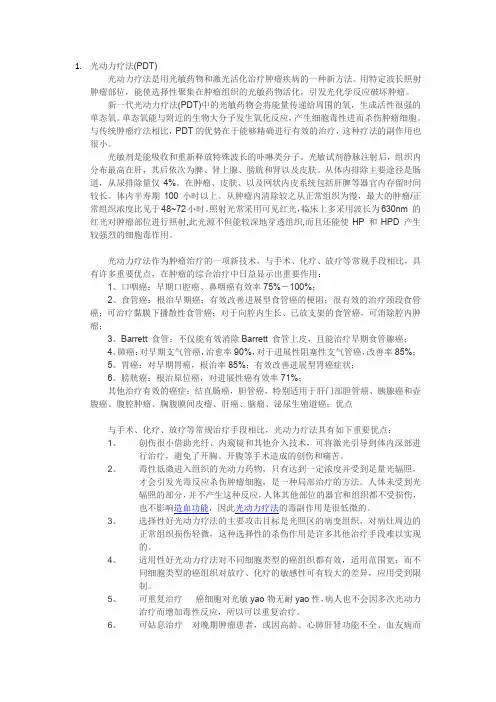
1.光动力疗法(PDT)光动力疗法是用光敏药物和激光活化治疗肿瘤疾病的一种新方法。
用特定波长照射肿瘤部位,能使选择性聚集在肿瘤组织的光敏药物活化,引发光化学反应破坏肿瘤。
新一代光动力疗法(PDT)中的光敏药物会将能量传递给周围的氧,生成活性很强的单态氧。
单态氧能与附近的生物大分子发生氧化反应,产生细胞毒性进而杀伤肿瘤细胞。
与传统肿瘤疗法相比,PDT的优势在于能够精确进行有效的治疗,这种疗法的副作用也很小。
光敏剂是能吸收和重新释放特殊波长的卟啉类分子。
光敏试剂静脉注射后,组织内分布最高在肝,其后依次为脾、肾上腺、膀胱和肾以及皮肤。
从体内排除主要途径是肠道,从尿排除量仅4%。
在肿瘤、皮肤、以及网状内皮系统包括肝脾等器官内存留时间较长。
体内半寿期100小时以上。
从肿瘤内清除较之从正常组织为慢,最大的肿瘤/正常组织浓度比见于48~72小时。
照射光常采用可见红光,临床上多采用波长为630nm 的红光对肿瘤部位进行照射,此光源不但能较深地穿透组织,而且还能使HP 和HPD 产生较强烈的细胞毒作用。
光动力疗法作为肿瘤治疗的一项新技术,与手术、化疗、放疗等常规手段相比,具有许多重要优点,在肿瘤的综合治疗中日益显示出重要作用:1、口咽癌:早期口腔癌、鼻咽癌有效率75%-100%;2、食管癌:根治早期癌;有效改善进展型食管癌的梗阻;很有效的治疗颈段食管癌;可治疗黏膜下播散性食管癌;对于向腔内生长、已放支架的食管癌,可消除腔内肿瘤;3、Barrett 食管:不仅能有效消除Barrett 食管上皮,且能治疗早期食管腺癌;4、肺癌:对早期支气管癌,治愈率90%,对于进展性阻塞性支气管癌,改善率85%;5、胃癌:对早期胃癌,根治率85%;有效改善进展型胃癌症状;6、膀胱癌:根治原位癌,对进展性癌有效率71%;其他治疗有效的癌症:结直肠癌,胆管癌,特别适用于肝门部胆管癌、胰腺癌和壶腹癌、腹腔肿瘤、胸腹膜间皮瘤、肝癌、脑瘤、泌尿生殖道癌;优点与手术、化疗、放疗等常规治疗手段相比,光动力疗法具有如下重要优点:1、创伤很小借助光纤、内窥镜和其他介入技术,可将激光引导到体内深部进行治疗,避免了开胸、开腹等手术造成的创伤和痛苦。
局部光动力疗法在损容性皮肤病应用中的进展光动力反应是在光敏剂和光辐射作用下所导致的依赖于氧化反应的一种组织反应。
光动力疗法最初是作为治疗各种人类肿瘤的经验方法,现在该疗法不仅应用于非黑素细胞瘤,而且还用于痤疮、光线性角化病、基底细胞癌等损容性皮肤病的治疗。
近十年来,光动力疗法在全世界得到了普及,其治疗需要光敏剂、光源照射及病变组织中的氧这三个条件同时存在。
由于系统应用光敏剂使光毒性延长,故光敏剂药物在皮肤科倾向于局部使用。
本文就光敏剂、光源及其临床疗效作如下综述。
1 光敏剂最早用作光敏剂的染料如伊红或真曙红是用于治疗花斑癣、银屑病、传染性软疣、梅毒、寻常狼疮及皮肤癌等。
20世纪70年代后期,Dougherty使用血卟啉衍生物来治疗皮肤癌,又一次掀起了光动力疗法的高潮。
使用血卟啉衍生物的主要问题在于皮肤光敏性持续时间长达8周,由于血卟啉衍生物中存在大分子的四吡咯环不能透过皮肤,故不能在局部应用。
因此Kennedy在1990年使用能透过表皮的小分子量卟啉前体5-氨基酮戊酸(5-aminolevulinic acid,5-ALA)或甲基氨基酮戊酸盐(methyl aminolevulinate,MAL),这是光动力疗法在皮肤科应用的一个里程碑。
最近研究的焦点是研制和评估局部光敏剂的疗效,如凝血因子X的前体5-ALA或者MAL诱导的光敏性物质卟啉。
这些化学制剂不会象系统应用卟啉及其衍生物那样产生强烈的全身表皮的光敏作用。
MAL联合红光可治疗基底细胞癌和光线性角化病。
5-ALA的盐酸化合物联合蓝光亦可治疗痤疮和光线性角化病。
以5-ALA为基础的光敏剂自身并非是光敏的,而是通过优先蓄积在病变组织中的细胞内,并且选择性地在第X因子生物合成作用下代谢成光敏化的卟啉。
相对血卟啉衍生物,第二代光敏剂仅对表皮具有光毒性。
2光源光敏性的卟啉在凝血因子X的合成过程中形成,它们可以在一定波长的光线下被激活。
卟啉或相关的光敏性物质具有典型的吸收光谱,峰值约405nm。
光动力疗法光动力疗法(PDT)是使用光敏药物和光源来破坏异常细胞的治疗。
它可以用于治疗某些皮肤和眼睛疾病,以及某些类型的癌症。
就药物和光源本身而言是无害的,但是当药物暴露于光源时,会损伤附近细胞。
因此光动力治疗可以在不需要手术的情况下处理小的异常组织区域。
PDT的应用PDT可用于治疗光源可以到达的身体部位,例如皮肤,眼睛,嘴,食道(食道)和肺中的异常细胞。
PDT可用于治疗下列病症:(1)光化性角化病:由多年阳光照射造成的皮肤干燥鳞状斑块,如果不进行治疗可能会癌变;(2)鲍温病:皮肤癌的早期形式;(3)基底细胞癌:一种皮肤癌;(4)黄斑变性:可导致视力丧失的眼科疾病;(5)巴雷特食管:食管下端的细胞的变化,如果不治疗可能癌变;(6)食管癌,口腔癌和肺癌:如果在早期使用PDT可以治愈一些癌症,或在严重的病例中缓解症状。
PDT在治疗某些其它类型的癌症以及疣,痤疮和乳房外Paget病(影响腹股沟中和周围皮肤的癌前病症)方面也显示出良好的前景。
PDT期间会发生什么PDT在两个阶段中进行:(1)制备阶段:首先,需要进入医院给予光敏药物,根据待治疗部位的面积,药物可以是霜剂,注射剂或特殊饮料;一旦给予药物,患者可能被要求回家并在几小时或几天内返回,这将使药物在异常细胞中积聚。
(2)光处理阶段:返回医院或诊所进行光疗,这将涉及将灯或激光照射到治疗区域大约10-45分钟;为了治疗身体内部的异常细胞,例如在肺部,内窥镜(柔性管)将被送入身体以传递光;有时,局部麻醉剂可用于麻醉治疗区域,或者可以给予药物以帮助在手术过程中放松。
PDT治疗后皮肤治疗后,用敷料覆盖大约1天。
护理人员会告知确切的时间。
尽量避免划伤或敲击处理区域,并尽可能保持干燥。
一旦建议去除敷料,就可以正常清洗和洗澡。
治疗后医生将安排患者在医院随访,以评估治疗是否有效,并决定是否需要重复治疗。
接受治疗的部位通常需2-6周的时间才能完全愈合,具体时间取决于所接受治疗的部位以及面积有多大。
光动力疗法及其临床的主要应用:
光动力疗法是一种新型的治疗方法,主要应用于医学领域。
它的基本原理是利用特定波长的光线激活某些光敏物质,产生化学反应,从而破坏病变组织或杀死癌细胞。
光动力疗法在临床上的应用非常广泛,主要包括以下几个方面:
1.肿瘤治疗:光动力疗法可以用于治疗各种类型的肿瘤,如皮肤癌、肺癌、消化道肿
瘤等。
通过向肿瘤组织注射光敏剂,再用特定波长的光线照射,可以杀死癌细胞并缩小肿瘤体积。
2.皮肤疾病治疗:光动力疗法可以用于治疗各种皮肤疾病,如痤疮、扁平疣、尖锐湿
疣等。
通过向病变组织注射光敏剂,再用特定波长的光线照射,可以破坏病变组织并促进皮肤修复。
3.感染性疾病治疗:光动力疗法还可以用于治疗各种感染性疾病,如口腔溃疡、牙周
炎、尿路感染等。
通过向感染部位注射光敏剂,再用特定波长的光线照射,可以杀死病原体并促进组织修复。
局部5-ALA光动力疗法治疗脂溢性角化病的疗效观察鲁元刚;伍津津;杨宏珍;贺洋;杨亚东;郑小丽【期刊名称】《中国激光医学杂志》【年(卷),期】2009(18)2【摘要】目的观察局部5-ALA光动力疗法治疗面部脂溢性角化病的疗效和安全性。
方法脂溢性角化病15例患者。
将20%的5-ALA溶液浸润薄海绵片后覆盖面部皮损处,避光3h。
移除湿敷海绵,用波长为635nm的激光照射病灶部位,能量密度120J/cm2,照射时间15~20min。
治疗后10d、1个月复诊,评价治疗效果。
结果治疗后10d,13例患者完全治愈,2例第2次治疗后1个月治愈。
患者满意率为100.0%。
结论局部5-ALA光动力疗法治疗脂溢性角化病疗效显著,美容效果理想,不良反应小。
【总页数】4页(P92-94)【关键词】光动力疗法;脂溢性角化病;5-氨基乙酰丙酸【作者】鲁元刚;伍津津;杨宏珍;贺洋;杨亚东;郑小丽【作者单位】第三军医大学大坪医院野战外科研究所皮肤科美容中心【正文语种】中文【中图分类】R454.2【相关文献】1.光动力疗法联合复方倍他米松局部封闭治疗增生性瘢痕疗效观察 [J], 姚建;苏开新;王海华;郭虎2.局部5-ALA光动力学疗法治疗重度炎性痤疮的疗效观察 [J], 王雁萍;杨雯;雷霞;周金玲;贺洋;鲁元刚3.光动力疗法治疗耳甲腔部位脂溢性角化病疗效观察 [J], 王爱琴;赵国伟;崔芹4.复方倍他米松局部皮损内注射联合5-氨基酮戊酸光动力疗法治疗囊肿性痤疮的疗效观察 [J], 陈美华;王德辉;沈琼曼;谢东斌;郭英俊5.5-ALA光动力疗法治疗裸鼠鼻咽癌移植瘤的疗效观察 [J], 谢莹;黄光武;韦正波;张哲;温文胜因版权原因,仅展示原文概要,查看原文内容请购买。
doi:10.1684/ejd.2015.2570TherapyEur J Dermatol 2015;25(4):296-311Colin MORTON 1Rolf-Markus SZEIMIES 2Alexis SIDOROFF 3Ann-Marie WENNBERG 4Nicole BASSET-SEGUIN 5PiergiacomoCALZA V ARA-PINTON 6Yolanda GILABERTE 7Günther HOFBAUER 8Robert HUNGER9Sigrid KARRER 10Percy LEHMANN 11Stefano PIASERICO 12Claas ULRICH 13Lasse BRAATHEN 9,on behalf of the European Dermatology Forum1Department of Dermatology,Stirling Community Hospital,Stirling,FK82AU,UK2Department of Dermatology &Allergology,Knappschaftskrankenhaus Recklinghausen,Recklinghausen,Germany3Department of Dermatology and Venereology,Medical University Innsbruck,Austria4Department of Dermatology,Sahlgrenska University Hospital,Gothenburg,Sweden5Department of Dermatology,Hôpital Saint Louis,Paris,France6Department of Dermatology,Spedali Civili,Brescia,Italy 7Department of Dermatology,Hospital San Jorge,Huesca,Spain8Department of Dermatology,Zurich University Hospital,Zürich,Switzerland9Department of Dermatology Bern,Bern,Switzerland10Department of Dermatology,University Hospital Regensburg,Regensburg,Germany11Department of Dermatology,HELIOS Klinikum Wuppertal,Germany12Unit of Dermatology,Department of Medicine,University of Padova,Italy 13Skin Cancer Centre,Hautklinik der Charitie,Berlin,GermanyReprints:C.Morton <colin.morton@>Article accepted on 15/3/2015European Dermatology Forum Guidelines on topical photodynamic therapyTopical photodynamic therapy (PDT)is a widely approved therapy for actinic keratoses,squamous cell carcinoma in-situ ,superficial and cer-tain thin basal cell carcinomas.Recurrence rates are typically equivalent to existing therapies,although inferior to surgery for nodular basal cell carcinoma.PDT can be used both as a lesional or as a field therapy and has the potential to delay/reduce the development of new lesions.PDT has also been studied for its place in the treatment of,as well as its poten-tial to prevent,superficial skin cancers in immune-suppressed patients,although sustained clearance rates are lower than for immunocompetent individuals.Many additional indications have been evaluated,including photo-rejuvenation and inflammatory and infective dermatoses.This S2guideline considers all current and emerging indications for the use of topical photodynamic therapy in Dermatology,prepared by the PDT subgroup of the European Dermatology Forum guidelines committee.It presents consensual expert recommendations reflecting current pub-lished evidence.An unabridged version of this guideline is available online at:/edf/index.php/edf-guidelines.Key words:5-aminolaevulinic acid,dermatology,guidelines,methyl aminolaevulinate,non-melanoma skin cancer,photodynamic therapyI n addition to undertaking a systematic literaturereview,these guidelines include evidence reviewed in therapy specific guidelines published in2007[1],2008 [2]and2013[3,4]and disease-specific EDF guidelines on actinic keratosis(2011[5])and basal cell carcinoma(2012 [6]).Photodynamic therapy involves the activation of a photo-sensitizing drug by visible light to produce reactive oxygen species within target cells,resulting in their destruction [7,8].In dermatological indications,PDT is usually per-formed by topical application of precursors of the haeme biosynthetic pathway,in particular5-aminolaevulinic acid (5-ALA)or its ester,methyl aminolaevulinate(MAL),con-verted within target cells into photo-active porphyrins, especially protoporphyrin IX(PpIX).After an incubation period,light of an appropriate wavelength activates the pho-tosensitizer promoting the photodynamic reaction.Before light illumination,it is possible to detect skin surfacefluo-rescence,assisting detection and delineation of both visible and incipient lesions.Three agents are currently licensed for use in Europe:Methyl aminolaevulinate(160mg/g)(MAL) Metvix®/Metvixia®(Galderma,Paris,France)is used along with red light to treat non-hyperkeratotic actinic keratosis(AK),squamous cell carcinoma in-situ(SCC in-situ/Bowen’s disease),superficial and nodular basal cell carcinomas(sBCC,nBCC),although approvals vary between countries.A patch containing5-ALA(Alacare®(Galderma-Spirig AG,Egerkingen,Switzerland))is approved for mild AK in a single treatment in combination with red light.Furthermore for AK,a nanoemulsion (Ameluz®(Biofrontera AG,Leverkusen,Germany))is licensed for PDT in combination with red light for the treatment of mild and moderate AK.A20%formulation of5-ALA,Levulan(DUSA Pharmaceuticals,USA),is approved in N.America and certain other countries for AK,in a protocol that uses blue light.Treatment is generally well tolerated but discomfort/pain is common during PDT.Alterations in the way PDT is delivered,including the use of daylight or shorter photo-sensitizer application times,are associated with decreased discomfort.PhotosensitizersALA is hydrophilic whilst MAL is more lipophilic,and hence MAL may penetrate more deeply,although compar-ison studies have failed to show a difference in response [9–11].A nanoemulsion of ALA was recently compared with MAL,with a higher clearance of AK of78%vs.64% 12weeks after the last treatment[12].PDT using a self-adhesive,5-ALA patch,has been shown to be superior to cryotherapy for mild and moderate thickness AK[13]. Enhancing penetration of a photosensitizer may increase treatment efficacy but currently there is no approval for a penetration enhancer or iontophoresis.Elevating skin tem-perature during ALA application may improve efficacy as PpIX production is a temperature-dependant process[14]. In nodular BCC of up to2mm thickness,a3-hour applica-tion of160mg/g MAL showed the highest selectivity for tumour and is licensed for two treatments one week apart for BCC[15].It is also licensed as a double treatment for SCC in-situ(Bowen’s disease),but in AK one initial treatment is recommended,with non-responders receiving a second treatment at three months.The20%ALA formulation used with the Blu-U TM system is licensed for a drug light inter-val of18-24hours but shorter intervals of around1hour are widely practised[16].A shorter incubation time of1 hour with MAL for AK is also an option,given that in a comparison of1h vs.3h,overall lesion response rates were 76%vs.85%respectively[17].Additional topically applied photosensitizers have been assessed,including indocyanine green,compared with indole-3-acetic acid,for acne with both agents equally effective[18].Topical hypericin has been studied in several indications with relatively disappointing results[19,20]. Similarly,topical silicon phthalocyanine PDT has been demonstrated to trigger apoptosis in various cutaneous neo-plasms[21].PDT using the cationic photosensitizer3,7-bis (N,N-dibutylamino)phenothiazin-5-ium bromide reduced the bacterial load in chronic wounds with a trend towards wound healing in a recent trial[22].Light sources and dosimetryA range of light sources can be used for PDT,includingfil-tered xenon arc and metal halide lamps,fluorescent lamps and light emitting diodes(LED)and even rge fields can be treated using narrowband LED devices e.g. the Aktilite128(Galderma,Paris,France),BF-Rhodo LED (Biofrontera,Leverkusen,Germany)and Omnilux PDT (Phototherapeutics,London,UK),each with an output that matches the630/635nm activation peak of PpIX whilst excluding the extraneous wavelengths present in broad-band sources e.g.PhotoDyn750/505(Hydrosun,Germany) and Waldmann PDT1200L(Waldmann,Germany),permit-ting shorter irradiation times.Filtered intense pulsed lights (IPLs)have been successfully used in PDT although they emit different spectra,resulting in a need to derive specific protocols to achieve identical radiant exposures[23].There is evidence of higher response rates with narrow spectrum sources,with patient clearance rates of85%and68%for BF-200ALA-PDT or MAL-PDT respectively,compared with72%and61%when broad-spectrum devices were used [12,24].Most light sources for PDT use the630nm absorption peak in the red region,in order to improve tissue penetration, although a bluefluorescent lamp(peak emission417nm) is recommended in Levulan-PDT.Dosimetry for emerging inflammatory/infective dermatoses is not yet standardized although high and low dose protocols are described for acne [25].Discontinuous illumination(fractionation)may improve the efficacy of PDT by permitting tissue re-oxygenation during‘dark’periods.Studies support the superiority of fractionation in ALA-PDT for sBCC,but not in SCC in-situ [26,27].Overall clearance of95%after a2-year follow-up has been reported in a large series of552lesions(AK,SCC in-situ,sBCC,nBCC)following ALA-PDT using two light fractions of20and80J/cm2at4and6hours[28].Supe-rior clearance of AK treated by fractionated ALA-PDT (using the same protocol)at3months of96%compared with89%for lesions treated to standard protocol(2treat-ments7days apart)with12-month clearance rates both onlyslightly lower at94%and85%respectively[29].An alter-native protocol of two doses of75J/cm2at4and5hours was associated with an initial94%clearance rate for nBCC but with a failure rate of30%by3years[30].Differences in localization between the agents,with an altered response of endothelial cells to ALA and MAL-PDT noted in-vivo, may explain why no similar efficacy improvement has yet been observed with fractionated MAL-PDT[31]. Daylight can also be used as the light source for PDT with application of MAL for0.5hour,followed by exposure to daylight for up to2.5hours[32].Daylight MAL-PDT is as effective as conventional treatment for AK,with the advan-tage of only minimal pain.No inferiority was observed by reducing the daylight exposure to1.5hours although the response was greater for thinner AK[33,34].Daylight-PDT has recently been assessed for treating BCC[35]. Patients can wear a portable LED device,permitting ambu-latory PDT to reduce the need for hospital attendance[36]. Efficacy has been reported in three studies with the largest achieving84%lesion clearance,predominantly sBCC and SCC in-situ,1year following2treatments,one week apart, with minimal pain[36–38].Dosimetry in PDT is defined by photosensitizer dose,drug-light interval,wavelength/band,irradiance andfluence of light.Total effectivefluence,taking into account irradi-ance,optical transmission through tissue and absorption by photosensitizer,has been proposed as a method for more accurate dosimetry but,in practice,light dosage can only be estimated from the energyfluence[39].Lesion preparationProtocols for PDT in Europe conventionally recommend some form of lesion preparation to enhance photosensitiz-ing agent absorption and light penetration.Studies using the ALA plaster for mild and moderate thickness AK did not require prior preparation,with results consistent with stan-dard protocols[13,14].Some practitioners have observed reduced efficacy if lesions are not debrided prior to PDT [14,17],while others have not noted increased drug uptake following lesion preparation of SCC in-situ and BCC[41]. Lesion preparation is probably more important when treat-ing nodular BCC by PDT with recommended practice to gently remove overlying crust with a curette/scalpel in a manner insufficient to cause pain,and thus not requiring local anaesthesia.Some practitioners perform a more for-mal lesion debulking days/weeks prior to PDT,with92% of BCC clearing following a single session of ALA-PDT in one study[42].In a small comparison study of PDT (ALA and MAL),with or without debulking immediately pre-photosensitizer application,residual nodular BCC was more often observed in BCCs that were not debulked[10]. Additional techniques of skin preparation have been reported,including microneedling,skin vaporization with CO2laser,or ablative fractional resurfacing prior to PDT [43–46].Practitioners typically cover treatment sites with light occlusive dressings,on the presumption that full expo-sure to ambient light during the incubation period will lead to increased activation of PpIX superficially,reducing the opportunity for deeper photosensitizer penetration before photoactivation.PDT with occlusion is standard practice in MAL-PDT of AK,SCC in-situ and BCC but is not per-formed when using Levulan PDT for facial AK.The most recent studies of daylight PDT also do not require initial occlusion[34].Treatment protocolsStandard PDTRecommended protocols in Europe for ALA-PDT and MAL-PDT using currently licensed photosensitizing agents for non-melanoma skin cancer indications involve the appli-cation of the topical photosensitizing agent for3-4hours, depending on agent,with occlusion,to be followed by illu-mination most often using a narrowband red LED light source(∼630nm,light dose of37J/cm2).Daylight PDTDaylight PDT is performed with initial widespread appli-cation of an organic sunscreen followed approximately15 minutes later by lesion preparation,then MAL cream is applied to the treatment area,without occlusion.After30 minutes application,patients are exposed to daylight for 1.5-2.0hours when treating AK[34,47].Ambulatory PDTThe light emitting‘plaster’is applied to the lesion after routine preparation and cream application and the device automatically switches on after the incubation period to deliver a total dose of75J/cm2at7mW/cm2[38].Another approach under trial is the integration of an opticalfibre in aflexible textile structure coupled to a portable laser light source adjustable to the appropriate wavelengths[48].Fluorescent diagnosisThe detection of skin surfacefluorescence following appli-cation of ALA or MAL,using a Wood’s lamp or CCD camera system,may assist in lesion definition as well as in identifying persistent/recurrent disease that may not be clinically obvious[49].Fluorescence imaging has given inconsistent results when used to determine tumour boundaries to improve surgical efficacy during Mohs micro-graphic surgery and has not been shown to be substantially superior to simple clinical assessment of tumour margins [50,51].Measurement offluorescence during MAL-PDT has shown the extent of photobleaching but not the total initial pro-toporphyrin IXfluorescence,to be predictive of lesion clearance[52].In another study,fluorescence diagnosis in intraepidermal neoplasias was unable to discriminate between lesions or proliferative activity,with hyperkerato-sis an important determinant offluorescence intensity[53]. Intensity of pain is associated withfluorescence intensity and may help identify patients more likely to require active pain management[54].Current indicationsActinic keratoses(Strength of Recommendation A,Quality of Evidence1)PDT has been widely studied for thin and moderate thick-ness AK on the face and scalp with clearance rates of licensed products of81-92%three months after treatment to current protocols[12,13,24,55–57].One-year lesion clearance rates of78%and63-79%have been reported fol-lowing ALA-PDT(up to2treatments)and patch ALA-PDT (single treatment)respectively[40,58].An initial double treatment of MAL-PDT,7days apart, does not confer advantage in clearing thin AK,although fewer moderate thickness lesions clear on a single ini-tial treatment[56].The response rate improved after a repeat treatment at3months,when required.A random-ized intra-individual study of1501face/scalp AK in119 patients used this protocol to compare MAL-PDT with cryotherapy[57].After the initial cycle of treatments, PDT resulted in higher cure rate than cryotherapy(87% vs.76%),but with equivalent outcome after non-responders were retreated(89%vs.86%).ALA-PDT using a20%formulation and blue light cleared 75%or more of all lesions in77%patients using14-18hour ALA application[55].Following a second treatment,where required,the clearance rate increased to89%at week12. ALA-PDT using BF-200nanoemulsion was superior to MAL for thin and moderate thickness AK,with clearance of90%vs.83%of lesions12weeks after one or two PDT treatments[12].Another randomized study observed over-all clearance of81%of lesions following BF-200ALA PDT compared with a22%placebo response.Superior patient and lesion clearance rates were noted in those illu-minated by a narrowband red LED source(96%and99% respectively)compared with broadband light[24].Similar recurrence rates were observed following BF200ALA-PDT and MAL-PDT of22%and25%respectively at12 months[59].ALA-PDT using the self-adhesive patch cleared82%-89% of mild or moderate AK,superior to cryotherapy(77%) [13].Twelve months after the single treatment,patch ALA-PDT remained superior to cryotherapy[40].MAL-PDT using daylight is as effective in clearing AK but is less painful than conventional PDT,with a lesion reduction after a single treatment of79%compared with 71%,respectively[32].Daylight exposure of1.5hours is as effective as the2.5hours but lesion response is highest for thin lesions(76%)compared with61%and49%for mod-erate and thick AK[33,34].A study assessing the impact of latitude identified that daylight PDT can be performed throughout summer and until mid-September in Reykjavik and Oslo,late October in Copenhagen and Regensburg, mid-November in Turin and all year in Israel[60].A study comparing MAL-PDT with cryotherapy for AK on the extremities demonstrated inferior efficacy with PDT, with clearance of78%of lesions at6months compared with 88%for cryotherapy[61].However,in a right/left compari-son study with imiquimod,ALA-PDT cleared significantly more moderate thickness AK lesions(58%vs.37%)and equivalent numbers of thin AK on the hands/forearms(72% lesions)[62].Actinic cheilitis has also been treated by PDT,with26/40 patients clear at3months following ALA-PDT,although with histological evidence of recurrence in9patients by18 months[63].MAL-PDT cleared cheilitis in7/15although histological clearance was evident in only4[64].In a recent retrospective analysis,27/43patients with actinic cheilitis cleared with response maintained after4.2±5.9 months[65].Sequential MAL-PDT then imiquimod5% cream achieved a histological cure of73%in a study of30 patients,suggesting an improved outcome using combina-tion treatment[66].Therapy guidelines identify PDT as effective both as a lesion andfield-directed treatment and suggest PDT has a role where AK are multiple/clustered and at sites of poor healing[67,68].In a randomized comparison of patient tolerance to MAL-PDT and topical imiquimod for multi-ple face/scalp AK,a high level of satisfaction was observed with both therapies,with PDT slightly superior[69].Squamous cell carcinoma in-situ(Bowen’s disease)/Invasive SCCSquamous cell carcinoma in-situ(Strength of Recommendation A,Quality of Evidence1)Invasive SCC(Strength of Recommendation D,Quality of Evidence11-iii).Lesion clearance rates of88-100%are reported for SCC in-situ3months after one or two cycles of MAL-PDT,with68-89%of treated lesions remaining clear over17-50months[70–74].MAL-PDT using a broadband red light was compared with cryotherapy or topical5-fluorouracil(5-FU)in a study with 225patients[70].The3month lesion clearance rates were similar with all regimens(93%for MAL-PDT,86%for cryotherapy,83%for5-FU)but PDT gave superior cos-metic results.Sustained lesion clearance rates for the three therapies were similar after2years with68%of lesions cleared following PDT,60%after cryotherapy and59% after5-FU[71].A similar3-month efficacy of88%was observed following MAL-PDT for41SCC in situ,using the narrowband red LED sources now in routine use,with sustained clearance at24months of71%[72].Further open studies of51and43lesions treated by MAL-PDT observed 76%and89%sustained clearance after17and50months, respectively[73,74].MAL-PDT cleared22/23lesions over3cm,with only3 recurrences over a1year follow-up[75].ALA-PDT cleared 35/40of large(>2cm)lesions and44/45patches in10 patients with three or more SCC in situ,although with four lesions recurring in each group over1year[76].ALA-PDT using two penetration enhancers achieved an initial90%clearance of19SCC in situ but with only53% clear at5years[77].ALA-PDT has been compared with cryotherapy and with5-FU[78,79].PDT proved superior in efficacy and adverse events in comparison with5-FU,as well as being less painful compared with cryotherapy. Body site does not appear to impact efficacy of PDT with protoporphyrin IX accumulation identical in SCC in situ located on acral and non-acral sites[80].PDT has been reported to clear digital,subungual and nipple Bowen’s dis-ease and where it arises in a setting of poor healing[81–87]. PDT may offer an alternative for treating penile intraep-ithelial neoplasia,with one large series,using ALA-andMAL-PDT in10patients noted clearance in7,but later recurrence in4[88].Red LED light is used most often for PDT treatment of SCC in-situ,however,a square wave intense pulsed light,cleared all nine lesions in one series at4months[89].Although one patient with clinically diagnosed SCC in-situ treated with PDT was diagnosed with melanoma at the same site a few months following treatment,it is uncertain if the treatment contributed,given the lack of initial histology [90].Therapy guidelines recommend PDT as the treatment of choice for both large and small plaques of SCC in-situ on poor healing sites and a good choice for large lesions in good healing sites[91].In a patient-reported outcome study, satisfaction was high,with90%of respondents indicatinga very favourable impression of ALA-PDT for SCC in situ[92].There is reduced efficacy of PDT for micro-invasive and nodular invasive SCC where24month clearance rates of 57%and26%have been reported.In view of its metastatic potential and reduced efficacy rates,PDT is not recom-mended for invasive SCC[72].Basal cell carcinomaSuperficial Basal cell carcinoma(Strength of Recommendation A,Quality of Evidence1),Nodular Basal cell carcinoma(Strength of Recommendation A, Quality of Evidence1)MAL is currently the only photosensitizing agent approved for superficial and/or nodular BCC.Initial clearance rates of92-97%for sBCC were achieved with protocols of either 1single initial treatment or2treatments7days apart, followed by a repeat two-treatment cycle at3months,if required[93,94].Recurrence rates of9%at1year were noted in both studies,with22%of initially responding lesions recurring over5years of follow-up.91%of nodular BCC were clinically clear3months following MAL-PDT, with a sustained lesion clearance response rate of76%after 5years of follow-up[15,95].Histologically confirmed response rates were observed in a further two randomized studies of MAL-PDT for nBCC. Treatment site excisions revealed clearance in73%,most effective for facial lesions where89%achieved complete histological response[96].A poorer response was reported in a large series of194BCC,with an82%clearance rate for sBCC,but only33%of nodular lesions clearing following MAL-PDT by standard protocol.The authors describe no debulking of the tumour prior to PDT[97].PDT for BCC is conventionally delivered using LED light sources but in a pilot study of daylight MAL-PDT,90%of 30lesions were clear3months after a single cycle of two treatments one week apart,although6BCC recurred over 12months[35].MAL-PDT was equivalent to surgery(92%vs.99%ini-tial clearance,9%and0%recurrences at1year)for sBCC but inferior to excision for nBCC when recurrence rates are compared(91%vs.98%initial clearance,14%and 4%recurrences at5years)[94,95].Cosmetic outcome is superior following PDT compared with surgery. Clearance rates were equivalent when MAL-PDT was com-pared with cryotherapy for sBCC,97%and95%at3months respectively,with overall clearance after5years identical at76%of lesions initially treated but with superior cosme-sis following PDT[94].A comparison of MAL-PDT with imiquimod or topical5-FU for sBCC achieved tumour-free rates at12months of73%,83%,and80%,indicating that using these protocols,5-FU is non-inferior and imiquimod superior to one cycle of MAL-PDT[98].ALA has also been widely used in treating BCC,with a weighted initial clearance rate of87%noted for sBCC treated by ALA-PDT in a review of12studies,compared with53%for nodular lesions[99].When ALA-PDT was compared with cryotherapy for both superficial and nodu-lar BCC,there was no significant difference in efficacy although healing times were shorter and cosmesis superior with PDT[100].In a randomized comparison trial of single versus frac-tionated ALA-PDT for sBCC,5years after treatment, fractionated PDT produced a superior response(88%vs. 75%respectively)[26].Fractionated ALA-PDT was equiv-alent to surgery in initially clearing lesions but with a 31%failure rate over5years,compared with only2% following surgery when a different75J/75J protocol was used,although80%of lesions remained clear at2years using the20J/80J dosing described above[28,101].Suc-cess of treatment depended on tumour thickness,with a probability of recurrence-free survival over5years of94% if BCC≤0.7mm.In a comparison of PDT with min-imal curettage,pre-ALA application versus conventional surgery,there was also no evidence of superiority of PDT [102].Responsiveness of BCC is influenced by lesion thickness, with reduced efficacy with increasing tumour thickness in a study using ALA-PDT[103].Lesions in the H-zone also have reduced sustained clearance rates[104].A six-year clinical and histological follow-up of53BCCs treated by ALA-PDT reported81%of treated sites disease free at72 months[105].A large cohort of33patients with naevoid basal cell car-cinoma syndrome(NBCCS)were treated by topical or systemic PDT depending on whether the lesions were less than/greater than2mm thick on ultrasound,with an overall local control rate at12months of56.3%[106].A recent report observed that MAL-PDT for NBCCS improves patient satisfaction and reduces the need for surgical pro-cedures[107].Topical PDT is recommended as a good treatment for sBCC, and a fair treatment for low-risk nBCC[108].Given recur-rence rates that are higher than for surgery,PDT is best considered for thin nodular lesions where surgical excision is relatively contraindicated or where patient preference, reflecting past therapy history,co-morbidities and/or cos-metic considerations,results in a willingness to accept a higher risk of recurrence.Emerging indicationsTreatment of non-melanoma skin cancer in organ transplant recipients(Strength of Recommendation B,Quality of Evidence I)Organ transplant recipients(OTR)have a greatly increased incidence of SCC,with PDT suggested for treating AK or SCC in-situ[109,110].A prospective study compared theefficacy of ALA-PDT for AK and SCC in-situ in immuno-competent patients(IC)with OTR[111].At four weeks, complete remission rates were similar(IC94%vs.OTR 88%),but differed at12weeks(IC89%vs.OTR68%) and48weeks(IC72%vs.OTR48%)[111].Three month remission rates following MAL-PDT vary between71% and90%[112,113].Reduced efficacy of PDT in OTR may result from the large number of intraepithelial lesions, more prominent hyperkeratosis and an altered local immune response.Location of lesions also appears important for the outcome:the response for AK to PDT on the hands ranged between22and40%[112,113].In a comparison of MAL-PDT to topical5-FU,one-month clearance rates were89% and11%,with more pain but better cosmesis following PDT [114].Prevention of non-melanoma skin cancer in organ transplant recipients(Strength of Recommendation B,Quality of Evidence I)The increase in incidence of OTR to SCC has been attributed to impairment of the cutaneous immune-surveillance due to systemic immunosuppressive medica-tion with cyclosporine and azathioprine,known also to induce specific effects enhancing the potential for de-novo formation of NMSC[115–118].Regularly applied photo-protection can reduce AK lesion counts and PDT has also been investigated as a preventive therapy[119].MAL-PDT delayed the development of new lesions in an intra-patient randomised study of27OTR with AK(9.6vs.6.8months for control site)[120].In a multicentre study of MAL-PDT compared with no treatment in81OTR,there was an initial significant reduction in new lesions,mainly AK,but this effect was lost by27months,12months after the last of the5PDT treatments[121].No significant dif-ference in the occurrence of SCC was observed in a study of blue light ALA-PDT versus no treatment after2years follow-up in40OTR[122].However,another study of blue-light ALA-PDT,repeated at4-8week intervals for2years, observed a reduction in SCC in12OTRs,compared with the number developing in the year prior to treatment,with a mean reduction at12and24months of79%and95% [123].Field cancerization(Strength of Recommendation B,Quality of Evidence I)The concept offield cancerization was introduced by Slaughter in1953[124].In the skin,it suggests that the clin-ically normal appearing skin around AKs and SCCs have subclinical features of genetically damaged cells,which can potentially develop into a neoplastic lesion.In gen-eral oncology it is defined as the pathological and genetic changes found in the tissue peripheral to a tumour,result-ing from‘preconditioning’of the affected organ by various carcinogenic agents[125].The major carcinogen for skin cancer is UV radiation with UV induced Tp53mutations common in NMSC[126].In sun-exposed skin of patients over50years old,p53mutated clones can be found in> 70%[127].In animal models,these Tp53mutated clones represent an early stage of skin carcinogenesis[128].The presence of Tp53mutations defines at the molecular level UV-inducedfield cancerization in the skin[129].The subclinical changes offield cancerization can be eval-uated by reflectance confocal microscopy[130].Organ transplant patients have multiple clones of mutated cells on sun exposed skin with disappearance of Tp53cells and cellular atypia observed following PDT[131,132].A recent consensus noted that PDT might prevent new AKs and the transformation of AK to SCC in OTR and propose cyclic PDT[133].The preventive potential offield PDT in immunocompetent photo-damaged individuals was stud-ied,where ALA-PDT delayed new AK development by about6months[134].Cutaneous T-cell Lymphoma(CTCL)(Strength of Recommendation C,Quality of Evidence IIiii) Skin-infiltrating malignant lymphocytes are susceptible to PDT and ALA-PDT(non-standardised protocols) and MAL-PDT(BCC protocol)can achieve therapeutic response[135–144].Complete remission was observed in 4/5with unilesional patch,plaque and nodular disease after a median of6MAL-PDT treatments[142].MAL-PDT cleared plaque lesions in6/12after a mean of5.7treatments [143].Ten patients with unilesional patch and plaque dis-ease received2-6MAL-PDT treatments with clinical and histological clearance in5and a partial remission in two, with response maintained in6/7after8-31months[144]. In a retrospective observational study,only5/19patients with unilesional plaque stage or isolated lesions cleared, with two relapsing during follow-up[65].In a further retrospective study of12patients with paucilesional dis-ease,there were6complete responders,3partial,following monthly MAL-PDT repeated for6months[145].The above reports and series indicate a potential for PDT in localized patch/plaque CTCL,with a possible indica-tion for lesions in the body folds that cannot be exposed to phototherapy.Acne(Strength of Recommendation B,Qualityof Evidence I)P.acnes produces small amounts of porphyrins permitting a direct photodynamic effect without external sensitizer but the addition of topical ALA enhances porphyrin synthesis by the pilosebaceous unit[146,147].PDT can promote antimicrobial and anti-inflammatory effects,inhibition and destruction of sebaceous glands,and enhanced epidermal turnover promoting reduced follicular obstruction[148]. PDT can significantly reduce inflammatory lesions and decrease sebum excretion,supported by a study of13 patients with facial acne who all improved when treated with ALA-PDT[149,150].However,in another study, ALA-PDT reduced inflammatory lesions but without a reduction of P.acnes count nor sebum excretion[151].In a study of21patients,following2treatments,there was a68%reduction in inflammatory acne lesions after MAL-PDT,but no reduction in non-inflammatory lesions[152]. In a split-face study,the same group compared ALA-with MAL-PDT,observing a similar reduction in inflammatory lesions but ALA-PDT showed more prolonged and severe side-effects[11].In a split-face study in30patients com-paring MAL-PDT versus light only,a54%versus20% reduction in inflammatory parameters was noted between active and control groups,with non-significant difference in。